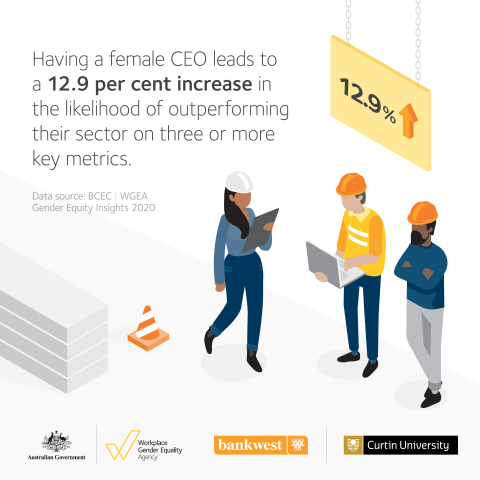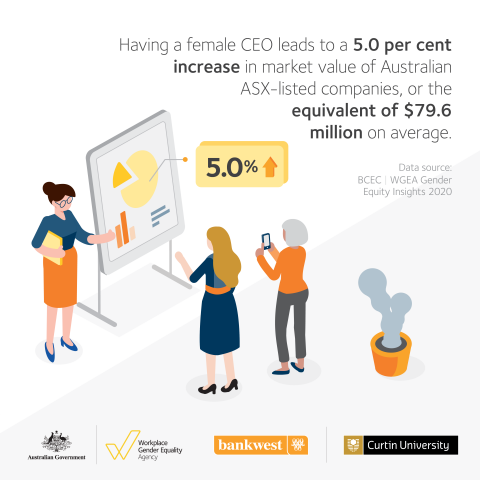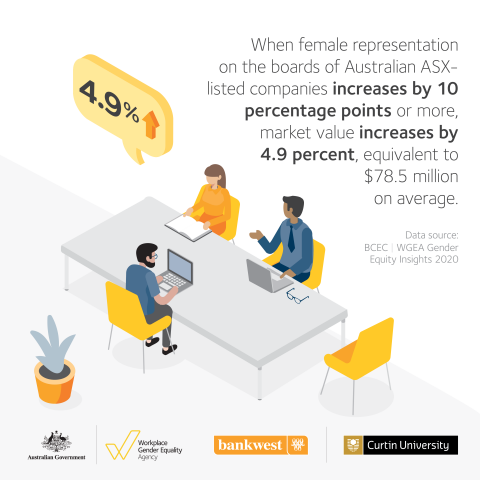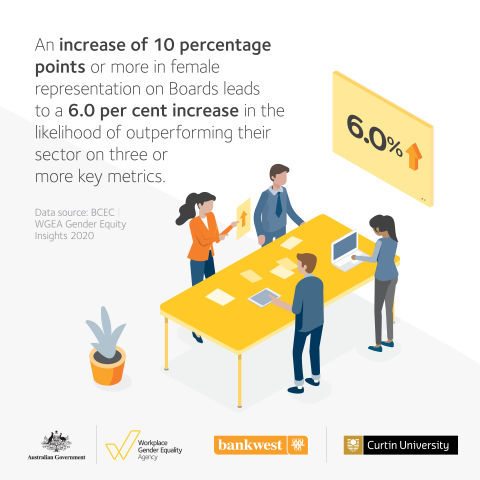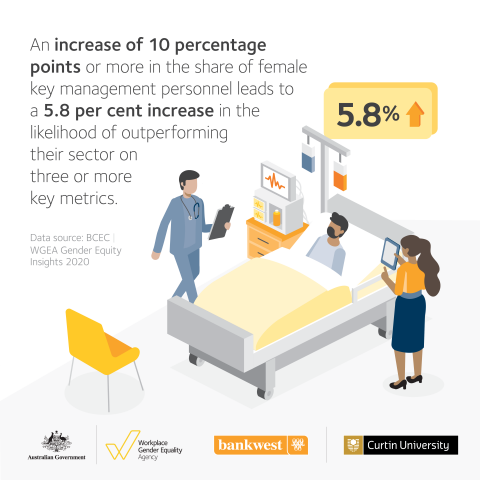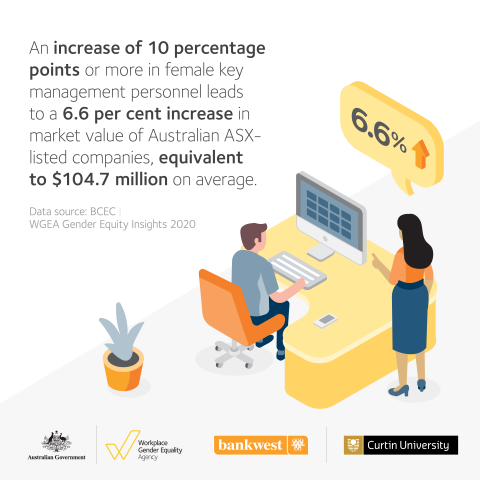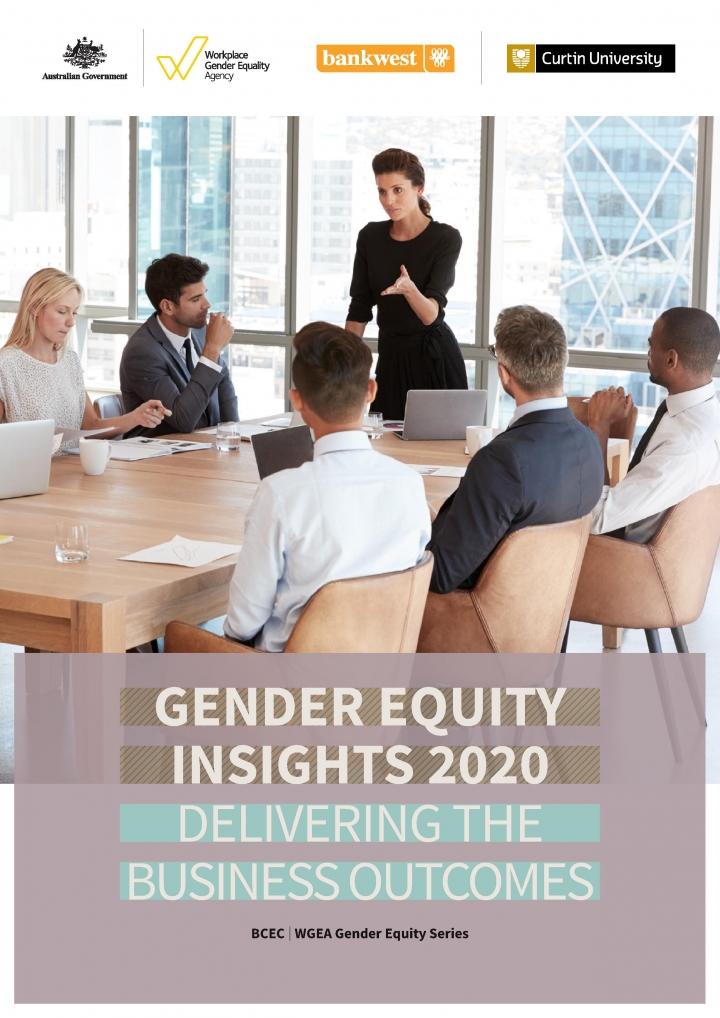- Profitability, performance and productivity increase under female leadership
- Female top-tier managers add 6.6. per cent to market value of ASX companies
- Female leadership will help business thrive in a post-COVID world.
As Australia moves towards economic recovery from the impact of the COVID-19 pandemic, a new report shows that more women on Boards and in senior leadership positions drives better company performance, greater productivity and greater profitability.
Research released today by the Bankwest Curtin Economics Centre (BCEC) and the Workplace Gender Equality Agency (WGEA) found that an increase in the share of female ‘top-tier’ managers by 10 percentage points or more led to a 6.6 per cent increase in the market value of Australian ASX-listed companies, worth the equivalent of AUD$104.7 million.
The report, Gender Equity Insights 2020: Delivering on Business Outcomes, reveals a strong and convincing causal relationship between an increase in the number of women in key decision-making positions and subsequent improvements in company performance.
Report author and BCEC Principal Research Fellow Associate Professor Rebecca Cassells said leadership has never been so important, especially when the world is dealing with the fallout and economic recovery from the COVID-19 pandemic.
“When businesses are looking to a post COVID-19 world, our research shows that having a female CEO has the potential to help companies navigate through the crisis,” Associate Professor Cassells said.
“In this report, we have identified a compelling causal relationship between an increase in the share of women in leadership and subsequent improvements in company performance.”
The report found that in Australian ASX-listed companies, having a female CEO led to a five per cent increase in their market value. This is worth the equivalent of AUD$79.6 million on average.
It also showed that increasing the number of women in leadership positions increased the likelihood of companies outperforming in their sector on three or more key profitability and performance metrics. These include return on equity, earnings before interest and tax, sales per worker, return on assets, dividend yield and Tobin’s Q.
Libby Lyons, Director of the Workplace Gender Equality Agency, hailed the BCEC research as a significant contribution to the international business case for gender equality.
“Using the Agency’s world-leading dataset, this ground-breaking study has provided important new evidence of the crucial need for improving gender diversity in company leadership. As we ‘snap forward’ to a post-COVID-19 economy, this report demonstrates that CEOs and senior executives must include gender equality as they develop recovery plans,” Ms Lyons said.
“This report provides tangible proof to support the established business case for gender equality. More gender-balanced leadership will improve the bottom line and financial performance of any organisation.
“Workplace gender equality is not just about fairness, it also has a compelling commercial imperative. This research provides hard evidence that more women in top-tier management levels will deliver improved profitability for business. Now more than ever, achieving workplace gender equality is an absolute necessity for every organisation in Australia.”
Associate Professor Cassells said that the new evidence is an important step towards delivering more gender equitable workplaces and understanding how they can improve the performance of Australian businesses.
“We found the appointment of a female CEO led to a five per cent increase in the market value of Australian ASX-listed companies. These companies also had a 12.9 per cent increase in the likelihood of outperforming the sector on three or more performance and profitability metrics,” Associate Professor Cassells said.
Report co-author and BCEC Director Professor Alan Duncan said the report’s findings show that Australian companies still have some way to go to achieve a better gender balance in key decision-making roles.
“Women are far less likely than men to be the Chair of the Board. While there has been progress towards a 30 per cent target for the share of women on company Boards, three in 10 companies in the WGEA dataset still have no female Board representation at all,” Professor Duncan said.
“Greater female representation on Boards and in senior leadership positions is better for business. Increasing the talent pool and taking into account the experiences and views of a broader group will ultimately lead to better decisions. This is particularly important as we look to rebuild our economy and broaden business and employment opportunities.”
“We found that an increase of 10 percentage points or more in female representation on Boards led to a 6.0 per cent increase in the likelihood of that company outperforming its sector on three or more performance and profitability metrics.”
Key findings:
- An increase of 10 percentage points or more in female representation on the Boards of Australian ASX-listed led to a 4/9 per cent increase in the company market value, worth the equivalent of AUD$78.5million for the average company
- An increase of 10 percentage points or more in female representation on Boards led to a 6.0 per cent increase in the likelihood of outperforming their peers on three or more metrics
- The appointment of a female CEO led to a 12.9 per cent increase in the likelihood of outperforming the sector on three or more metrics
- An increase of 10 percentage points or more in the share of female key management personnel led to a 5.8 per cent increase in the likelihood of outperforming their sector on three or more metrics
- Women are least likely to be the Chair of the Board, with only 14.1 per cent of women being Board Chairs
- Women make up only 17.1 per cent of company CEOs
- 29.8 per cent of companies have no female representation on their Board and a similar proportion of companies have no women in their key management teams
- Two-thirds of firms in the construction sector have zero female representation on their Boards.
Background:
The 2018-19 WGEA Gender Equality dataset is based on 4,841 reports submitted in accordance with the Act for reporting period 1 April 2018 to 31 March 2019. The dataset captures 4.3 million employees – which accounts for more than 40 per cent of all employees in Australia.
WGEA is an Australian Government statutory agency created by the Workplace Gender Equality Act 2012.
BCEC is an independent economic and social research organisation located within the Curtin Business School at Curtin University. The Centre was established in 2012 through the generous support of Bankwest, a division of Commonwealth Bank of Australia.
Notes to the Editor:
Copies of the report are available upon request. Selected charts from the report are provided below. Hi-resolution versions of all tables and charts in the report are available on request. Interviews with the report authors and Libby Lyons are available to be pre-scheduled, including print, online, radio and television.
Media Enquiries:
| Associate Professor Rebecca Cassells, Principal Research Fellow, BCEC | Professor Alan Duncan, Director, BCEC |
|
|
|
Lauren Sydoruk, Senior Media Consultant, Curtin University
|
Murray Black, Media and Communications Manager, WGEA
|
Infographics
